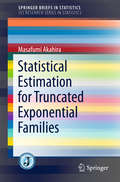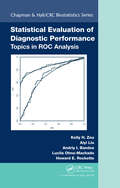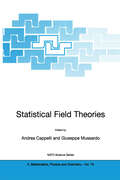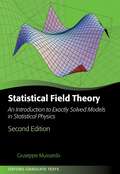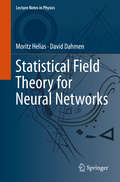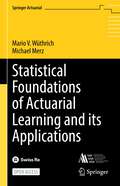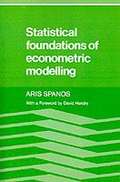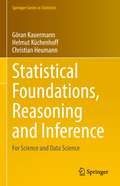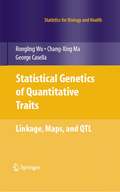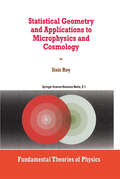- Table View
- List View
Statistical Electromagnetics
by Richard HollandThis book addresses the problem of treating interior responses of complex electronic enclosures or systems, and presents a probabilistic approach. Relationships for determining the statistics of the driving fields to apply to a circuit analysis code representing part of an enclosed system's writing are worked out. Also addressed are limited spatial and frequency coherence essential to a statistically based field drive model. This text gives examples, different modeling, and describes how to make, interchange, and optimize models.
Statistical Estimation: Asymptotic Theory (Stochastic Modelling and Applied Probability #16)
by I.A. Ibragimov R.Z. Has'minskiiwhen certain parameters in the problem tend to limiting values (for example, when the sample size increases indefinitely, the intensity of the noise ap proaches zero, etc.) To address the problem of asymptotically optimal estimators consider the following important case. Let X 1, X 2, ... , X n be independent observations with the joint probability density !(x,O) (with respect to the Lebesgue measure on the real line) which depends on the unknown patameter o e 9 c R1. It is required to derive the best (asymptotically) estimator 0:( X b ... , X n) of the parameter O. The first question which arises in connection with this problem is how to compare different estimators or, equivalently, how to assess their quality, in terms of the mean square deviation from the parameter or perhaps in some other way. The presently accepted approach to this problem, resulting from A. Wald's contributions, is as follows: introduce a nonnegative function w(0l> ( ), Ob Oe 9 (the loss function) and given two estimators Of and O! n 2 2 the estimator for which the expected loss (risk) Eown(Oj, 0), j = 1 or 2, is smallest is called the better with respect to Wn at point 0 (here EoO is the expectation evaluated under the assumption that the true value of the parameter is 0). Obviously, such a method of comparison is not without its defects.
Statistical Estimation for Truncated Exponential Families (SpringerBriefs in Statistics)
by Masafumi AkahiraThis book presents new findings on nonregular statistical estimation. Unlike other books on this topic, its major emphasis is on helping readers understand the meaning and implications of both regularity and irregularity through a certain family of distributions. In particular, it focuses on a truncated exponential family of distributions with a natural parameter and truncation parameter as a typical nonregular family. This focus includes the (truncated) Pareto distribution, which is widely used in various fields such as finance, physics, hydrology, geology, astronomy, and other disciplines. The family is essential in that it links both regular and nonregular distributions, as it becomes a regular exponential family if the truncation parameter is known. The emphasis is on presenting new results on the maximum likelihood estimation of a natural parameter or truncation parameter if one of them is a nuisance parameter. In order to obtain more information on the truncation, the Bayesian approach is also considered. Further, the application to some useful truncated distributions is discussed. The illustrated clarification of the nonregular structure provides researchers and practitioners with a solid basis for further research and applications.
Statistical Estimation of Epidemiological Risk (Statistics in Practice)
by Kung-Jong LuiStatistical Estimation of Epidemiological Risk provides coverage of the most important epidemiological indices, and includes recent developments in the field. A useful reference source for biostatisticians and epidemiologists working in disease prevention, as the chapters are self-contained and feature numerous real examples. It has been written at a level suitable for public health professionals with a limited knowledge of statistics. Other key features include: Provides comprehensive coverage of the key epidemiological indices. Includes coverage of various sampling methods, and pointers to where each should be used. Includes up-to-date references and recent developments in the field. Features many real examples, emphasising the practical nature of the book. Each chapter is self-contained, allowing the book to be used as a useful reference source. Includes exercises, enabling use as a course text.
Statistical Evaluation of Diagnostic Performance: Topics in ROC Analysis
by Kelly H. Zou Aiyi Liu Andriy I. Bandos Lucila Ohno-Machado Howard E. RocketteStatistical evaluation of diagnostic performance in general and Receiver Operating Characteristic (ROC) analysis in particular are important for assessing the performance of medical tests and statistical classifiers, as well as for evaluating predictive models or algorithms. This book presents innovative approaches in ROC analysis, which are releva
Statistical Extremes and Applications (Nato Science Series C: #131)
by J. Tiago De OliveiraThe first references to statistical extremes may perhaps be found in the Genesis (The Bible, vol. I): the largest age of Methu'selah and the concrete applications faced by Noah-- the long rain, the large flood, the structural safety of the ark --. But as the pre-history of the area can be considered to last to the first quarter of our century, we can say that Statistical Extremes emer ged in the last half-century. It began with the paper by Dodd in 1923, followed quickly by the papers of Fre-chet in 1927 and Fisher and Tippett in 1928, after by the papers by de Finetti in 1932, by Gumbel in 1935 and by von Mises in 1936, to cite the more relevant; the first complete frame in what regards probabilistic problems is due to Gnedenko in 1943. And by that time Extremes begin to explode not only in what regards applications (floods, breaking strength of materials, gusts of wind, etc. ) but also in areas going from Proba bility to Stochastic Processes, from Multivariate Structures to Statistical Decision. The history, after the first essential steps, can't be written in few pages: the narrow and shallow stream gained momentum and is now a huge river, enlarging at every moment and flooding the margins. Statistical Extremes is, thus, a clear-cut field of Probability and Statistics and a new exploding area for research.
Statistical Factor Analysis and Related Methods: Theory and Applications (Wiley Series in Probability and Statistics #418)
by Alexander T. BasilevskyStatistical Factor Analysis and Related Methods Theory andApplications In bridging the gap between the mathematical andstatistical theory of factor analysis, this new work represents thefirst unified treatment of the theory and practice of factoranalysis and latent variable models. It focuses on such areasas: * The classical principal components model and sample-populationinference * Several extensions and modifications of principal components,including Q and three-mode analysis and principal components in thecomplex domain * Maximum likelihood and weighted factor models, factoridentification, factor rotation, and the estimation of factorscores * The use of factor models in conjunction with various types ofdata including time series, spatial data, rank orders, and nominalvariable * Applications of factor models to the estimation of functionalforms and to least squares of regression estimators
Statistical Field Theories (NATO Science Series II: Mathematics, Physics and Chemistry #73)
by Andrea Cappelli Giuseppe MussardoRecent developments in theoretical physics include new instances of the unification of quite different phenomena. The theoretical community is challenged by the growing interactions between high-energy physics, statistical physics, and condensed matter physics. The common language, though, is exact solutions of two-dimensional and conformable field theories. This volume is a faithful representation of this interdisciplinary domain. Conformable and integrable field theories have been active research topics for several decades. The main recent developments concern the boundary effects and applications to disordered systems. The number of applications of the exact methods to condensed-matter problems has been growing over the years. Nowadays it is widely recognized that strongly interacting systems in low dimensions can be successfully described by integrable and conformable theories. This volume is an indispensable aid to those seeking to find their way in this domain.
Statistical Field Theory: An Introduction to Exactly Solved Models in Statistical Physics (Oxford Graduate Texts)
by Giuseppe MussardoFundamental concepts of phase transitions, such as order parameters, spontaneous symmetry breaking, scaling transformations, conformal symmetry and anomalous dimensions, have deeply changed the modern vision of many areas of physics, leading to remarkable developments in statistical mechanics, elementary particle theory, condensed matter physics and string theory. This self-contained book provides a thorough introduction to the fascinating world of phase transitions and frontier topics of exactly solved models in statistical mechanics and quantum field theory, such as renormalization groups, conformal models, quantum integrable systems, duality, elastic S-matrices, thermodynamic Bethe ansatz and form factor theory. The clear discussion of physical principles is accompanied by a detailed analysis of several branches of mathematics distinguished for their elegance and beauty, including infinite dimensional algebras, conformal mappings, integral equations and modular functions. Besides advanced research themes, the book also covers many basic topics in statistical mechanics, quantum field theory and theoretical physics. Each argument is discussed in great detail while providing overall coherent understanding of physical phenomena. Mathematical background is made available in supplements at the end of each chapter, when appropriate. The chapters include problems of different levels of difficulty. Advanced undergraduate and graduate students will find this book a rich and challenging source for improving their skills and for attaining a comprehensive understanding of the many facets of the subject.
Statistical Field Theory for Neural Networks (Lecture Notes in Physics #970)
by Moritz Helias David DahmenThis book presents a self-contained introduction to techniques from field theory applied to stochastic and collective dynamics in neuronal networks. These powerful analytical techniques, which are well established in other fields of physics, are the basis of current developments and offer solutions to pressing open problems in theoretical neuroscience and also machine learning. They enable a systematic and quantitative understanding of the dynamics in recurrent and stochastic neuronal networks. This book is intended for physicists, mathematicians, and computer scientists and it is designed for self-study by researchers who want to enter the field or as the main text for a one semester course at advanced undergraduate or graduate level. The theoretical concepts presented in this book are systematically developed from the very beginning, which only requires basic knowledge of analysis and linear algebra.
Statistical Foundations of Actuarial Learning and its Applications (Springer Actuarial)
by Mario V. Wüthrich Michael MerzThis open access book discusses the statistical modeling of insurance problems, a process which comprises data collection, data analysis and statistical model building to forecast insured events that may happen in the future. It presents the mathematical foundations behind these fundamental statistical concepts and how they can be applied in daily actuarial practice. Statistical modeling has a wide range of applications, and, depending on the application, the theoretical aspects may be weighted differently: here the main focus is on prediction rather than explanation. Starting with a presentation of state-of-the-art actuarial models, such as generalized linear models, the book then dives into modern machine learning tools such as neural networks and text recognition to improve predictive modeling with complex features. Providing practitioners with detailed guidance on how to apply machine learning methods to real-world data sets, and how to interpret the results without losing sight of the mathematical assumptions on which these methods are based, the book can serve as a modern basis for an actuarial education syllabus.
Statistical Foundations of Data Science (Chapman & Hall/CRC Data Science Series)
by Jianqing Fan Runze Li Cun-Hui Zhang Hui ZouStatistical Foundations of Data Science gives a thorough introduction to commonly used statistical models, contemporary statistical machine learning techniques and algorithms, along with their mathematical insights and statistical theories. It aims to serve as a graduate-level textbook and a research monograph on high-dimensional statistics, sparsity and covariance learning, machine learning, and statistical inference. It includes ample exercises that involve both theoretical studies as well as empirical applications. The book begins with an introduction to the stylized features of big data and their impacts on statistical analysis. It then introduces multiple linear regression and expands the techniques of model building via nonparametric regression and kernel tricks. It provides a comprehensive account on sparsity explorations and model selections for multiple regression, generalized linear models, quantile regression, robust regression, hazards regression, among others. High-dimensional inference is also thoroughly addressed and so is feature screening. The book also provides a comprehensive account on high-dimensional covariance estimation, learning latent factors and hidden structures, as well as their applications to statistical estimation, inference, prediction and machine learning problems. It also introduces thoroughly statistical machine learning theory and methods for classification, clustering, and prediction. These include CART, random forests, boosting, support vector machines, clustering algorithms, sparse PCA, and deep learning.
Statistical Foundations of Data Science (Chapman & Hall/CRC Data Science Series)
by Jianqing Fan Runze Li Cun-Hui Zhang Hui ZouStatistical Foundations of Data Science gives a thorough introduction to commonly used statistical models, contemporary statistical machine learning techniques and algorithms, along with their mathematical insights and statistical theories. It aims to serve as a graduate-level textbook and a research monograph on high-dimensional statistics, sparsity and covariance learning, machine learning, and statistical inference. It includes ample exercises that involve both theoretical studies as well as empirical applications. The book begins with an introduction to the stylized features of big data and their impacts on statistical analysis. It then introduces multiple linear regression and expands the techniques of model building via nonparametric regression and kernel tricks. It provides a comprehensive account on sparsity explorations and model selections for multiple regression, generalized linear models, quantile regression, robust regression, hazards regression, among others. High-dimensional inference is also thoroughly addressed and so is feature screening. The book also provides a comprehensive account on high-dimensional covariance estimation, learning latent factors and hidden structures, as well as their applications to statistical estimation, inference, prediction and machine learning problems. It also introduces thoroughly statistical machine learning theory and methods for classification, clustering, and prediction. These include CART, random forests, boosting, support vector machines, clustering algorithms, sparse PCA, and deep learning.
Statistical Foundations Of Econometric Modelling (PDF)
by Aris Spanos David HendryThis textbook provides an introduction to econometrics through a grounding in probability theory and statistical inference. The emphasis is on the concepts and ideas underlying probability theory and statistical inference, and on motivating the learning of them both at a formal and an intuitive level. It encourages the mastering of fundamental concepts and theoretical perspectives which guide the formulation and solution of problems in econometric modelling. This makes it an ideal introduction to empirical econometric modelling and the more advanced econometric literature. It is recommended for use on courses giving students a thorough grounding in econometrics at undergraduate or graduate level.
Statistical Foundations, Reasoning and Inference: For Science and Data Science (Springer Series in Statistics)
by Göran Kauermann Helmut Küchenhoff Christian HeumannThis textbook provides a comprehensive introduction to statistical principles, concepts and methods that are essential in modern statistics and data science. The topics covered include likelihood-based inference, Bayesian statistics, regression, statistical tests and the quantification of uncertainty. Moreover, the book addresses statistical ideas that are useful in modern data analytics, including bootstrapping, modeling of multivariate distributions, missing data analysis, causality as well as principles of experimental design. The textbook includes sufficient material for a two-semester course and is intended for master’s students in data science, statistics and computer science with a rudimentary grasp of probability theory. It will also be useful for data science practitioners who want to strengthen their statistics skills.
Statistical Framework for Recreational Water Quality Criteria and Monitoring (Statistics in Practice #65)
by Larry J. WymerWith increasing rates of pollution to both land and aquatic environments, regulations for the quality of our waters are necessarily becoming more stringent. In the light of recent epidemiological studies new criteria are being established for the safety of our recreational waters. In order for such criteria to be developed an established statistical framework needs to be in place. Statistical Framework for Recreational Water Quality Criteria and Monitoring offers a practical guide to the statistical methods used for assessing health effects and monitoring and modelling water quality Both traditional and novel sampling designs are discussed. Written by a team of international experts in the field, this book sets out to provide an essential structure for the monitoring of water quality. · Proposes a much-needed framework for the monitoring of water quality, and provides practical guidance on the statistical methods involved. · Covers risk characterization, empirical modelling, sensitivity analysis and measures of robustness. · Details sampling methods and quality control approaches. · Presents crucial, real-life results from recent large-scale studies of water quality, central to the development of the area. · Accompanied by a supplementary website hosting data sets and tools for data analysis. The book is primarily aimed at public health officials, staff of regulatory bodies and students and faculty members of environmental and statistical science courses. There is also much to benefit readers from environmental research and risk analysis.
Statistical Genetics of Quantitative Traits: Linkage, Maps and QTL (Statistics for Biology and Health)
by Rongling Wu Changxing Ma George CasellaThis book introduces the basic concepts and methods that are useful in the statistical analysis and modeling of the DNA-based marker and phenotypic data that arise in agriculture, forestry, experimental biology, and other fields. It concentrates on the linkage analysis of markers, map construction and quantitative trait locus (QTL) mapping, and assumes a background in regression analysis and maximum likelihood approaches. The strength of this book lies in the construction of general models and algorithms for linkage analysis, as well as in QTL mapping in any kind of crossed pedigrees initiated with inbred lines of crops.
Statistical Genomics: Linkage, Mapping, and QTL Analysis
by Ben Hui LiuGenomics, the mapping of the entire genetic complement of an organism, is the new frontier in biology. This handbook on the statistical issues of genomics covers current methods and the tried-and-true classical approaches.
Statistical Genomics: Linkage, Mapping, and QTL Analysis
by Ben Hui LiuGenomics, the mapping of the entire genetic complement of an organism, is the new frontier in biology. This handbook on the statistical issues of genomics covers current methods and the tried-and-true classical approaches.
Statistical Geometry and Applications to Microphysics and Cosmology (Fundamental Theories of Physics #92)
by S. RoyRecent results from high-energy scattering and theoretical developments of string theory require a change in our understanding of the basic structure of space-time. This book is about the advancement of ideas on the stochastic nature of space-time from the 1930s onward. In particular, the author promotes the concept of space as a set of hazy lumps, first introduced by Karl Menger, and constructs a novel framework for statistical behaviour at the microlevel. The various chapters address topics such as space-time fluctuation and random potential, non-local fields, and the origin of stochasticity. Implications in astro-particle physics and cosmology are also explored. Audience: This volume will be of interest to physicists, chemists and mathematicians involved in particle physics, astrophysics and cosmology.
Statistical Group Comparison (Wiley Series in Probability and Statistics #367)
by Tim Futing LiaoAn incomparably useful examination of statistical methods for comparison The nature of doing science, be it natural or social, inevitably calls for comparison. Statistical methods are at the heart of such comparison, for they not only help us gain understanding of the world around us but often define how our research is to be carried out. The need to compare between groups is best exemplified by experiments, which have clearly defined statistical methods. However, true experiments are not always possible. What complicates the matter more is a great deal of diversity in factors that are not independent of the outcome. Statistical Group Comparison brings together a broad range of statistical methods for comparison developed over recent years. The book covers a wide spectrum of topics from the simplest comparison of two means or rates to more recently developed statistics including double generalized linear models and Bayesian as well as hierarchical methods. Coverage includes: * Testing parameter equality in linear regression and other generalized linear models (GLMs), in order of increasing complexity * Likelihood ratio, Wald, and Lagrange multiplier statistics examined where applicable * Group comparisons involving latent variables in structural equation modeling * Models of comparison for categorical latent variables Examples are drawn from the social, political, economic, and biomedical sciences; many can be implemented using widely available software. Because of the range and the generality of the statistical methods covered, researchers across many disciplines-beyond the social, political, economic, and biomedical sciences-will find the book a convenient reference for many a research situation where comparisons may come naturally.
A Statistical Guide for the Ethically Perplexed
by Lawrence Hubert Howard WainerLauded for their contributions to statistics, psychology, and psychometrics, the authors make statistical methods relevant to readers' day-to-day lives by including real historical situations that demonstrate the role of statistics in reasoning and decision making. The historical vignettes encompass the English case of Sally Clark, breast cancer sc
Statistical Hypothesis Testing with Microsoft ® Office Excel ® (Synthesis Lectures on Mathematics & Statistics)
by Robert HirschThis book provides a comprehensive treatment of the logic behind hypothesis testing. Readers will learn to understand statistical hypothesis testing and how to interpret P-values under a variety of conditions including a single hypothesis test, a collection of hypothesis tests, and tests performed on accumulating data. The author explains how a hypothesis test can be interpreted to draw conclusions, and descriptions of the logic behind frequentist (classical) and Bayesian approaches to interpret the results of a statistical hypothesis test are provided. Both approaches have their own strengths and challenges, and a special challenge presents itself when hypothesis tests are repeatedly performed on accumulating data. Possible pitfalls and methods to interpret hypothesis tests when accumulating data are also analyzed. This book will be of interest to researchers, graduate students, and anyone who has to interpret the results of statistical analyses.
Statistical Hypothesis Testing with SAS and R
by Dirk Taeger Sonja KuhntA comprehensive guide to statistical hypothesis testing with examples in SAS and R When analyzing datasets the following questions often arise: Is there a short hand procedure for a statistical test available in SAS or R? If so, how do I use it? If not, how do I program the test myself? This book answers these questions and provides an overview of the most common statistical test problems in a comprehensive way, making it easy to find and perform an appropriate statistical test. A general summary of statistical test theory is presented, along with a basic description for each test, including the necessary prerequisites, assumptions, the formal test problem and the test statistic. Examples in both SAS and R are provided, along with program code to perform the test, resulting output and remarks explaining the necessary program parameters. Key features: • Provides examples in both SAS and R for each test presented. • Looks at the most common statistical tests, displayed in a clear and easy to follow way. • Supported by a supplementary website http://www.d-taeger.de featuring example program code. Academics, practitioners and SAS and R programmers will find this book a valuable resource. Students using SAS and R will also find it an excellent choice for reference and data analysis.
Statistical Hypothesis Testing with SAS and R
by Dirk Taeger Sonja KuhntA comprehensive guide to statistical hypothesis testing with examples in SAS and R When analyzing datasets the following questions often arise: Is there a short hand procedure for a statistical test available in SAS or R? If so, how do I use it? If not, how do I program the test myself? This book answers these questions and provides an overview of the most common statistical test problems in a comprehensive way, making it easy to find and perform an appropriate statistical test. A general summary of statistical test theory is presented, along with a basic description for each test, including the necessary prerequisites, assumptions, the formal test problem and the test statistic. Examples in both SAS and R are provided, along with program code to perform the test, resulting output and remarks explaining the necessary program parameters. Key features: • Provides examples in both SAS and R for each test presented. • Looks at the most common statistical tests, displayed in a clear and easy to follow way. • Supported by a supplementary website http://www.d-taeger.de featuring example program code. Academics, practitioners and SAS and R programmers will find this book a valuable resource. Students using SAS and R will also find it an excellent choice for reference and data analysis.


